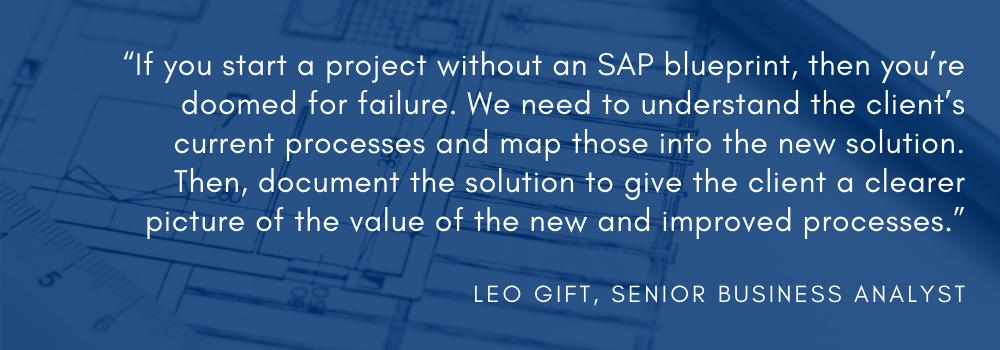
A to Z Guide to Creating a Bulletproof SAP Blueprint
Give your SAP software integration project the best chance of success with this guide on creating an SAP Blueprint. Learn about the uses and the challenges of the SAP blueprinting process.
What is the most important tool that architectures use to build a house? A blueprint!
Like software integration, tech personnel must, or at least should, use a blueprint to give them the best chance of succeeding in their goals. When you work with a team of tech personnel, it’s especially important for everyone on board to understand what the common goal is and how to reach it.
When it comes to implementing SAP software and solutions, it’s vital that you and your team plan out the details before starting. Set your project and team up for success with an SAP blueprint!
What is an SAP Blueprint?
For your information, a business blueprint provides the necessary information and instruction for key stakeholders to understand the direction of project and how that project will be monitored. Following that, the SAP blueprint describes your business processes and the system requirements for a well-defined foundation of the implementation project.
What you need to include in an SAP blueprint:
- Events/Milestones
- Deliverables
- Project status/Timeline
- List of team members and their roles
- User documents
- Business scenario descriptions
With this information, you and your team can use the SAP blueprint as a baseline to easily identify inefficiencies, train your employees and end-users, and preserve company knowledge for operational consistency. The bigger the SAP project, the more important an SAP blueprint will be for your company.
The Dangers of Not Using an SAP Blueprint: Why Use an SAP Blueprint?
Other than providing a project guideline, why should you use an SAP blueprint?

Planning an implementation project can be more important than the implementation itself. A standardized process with a blueprint helps identify mistakes early on to avoid time-consuming and costly fixes in the future.
For example, the Government of the Northern Territory of Australia lost $70 million on their asset management system integration with SAP when it originally costed $7 million. The project managers failed to plan the implementation properly to carry out and, as a result, their work was not ready to go live. Take this case as a lesson to ensure proper blueprinting of your SAP projects!
10 Steps to Creating the Perfect SAP Blueprint
- Develop a Process Inventory: Even if you know all the system processes at the top of your head, you should still note down the list of all your processes. The visual aspect of the list will help you determine how to prioritize your processes for the implementation.
- Establish an SAP Business Blueprint Foundation: Develop the scope definition document to outline the boundaries and basic information of your business processes.
- Draw the SAP Blueprint: Using the information from the previous step, determine which team and/or department will handle specific parts of the business processes to understand the chain of responsibilities.
- Estimate the Time and Cost: Determine the cost and timeline of this project. As well as, define your parameters to set up a baseline for benchmarking your progress during the project.
- Verify the Process of the SAP Blueprint: Get feedback from your stakeholders by running the details of the plan with your colleagues to verify the realities of the SAP blueprint.
- Deploy Improvement Techniques: Establish a project methodology that will add more business value, like reduce cycle time, to your processes by eliminating redundancy and adding automation.
- Define Internal Controls and Metrics: Help track your team’s progress by creating internal controls and metrics that increases the effectiveness and efficiency of the SAP business process.
- Conduct a Trial Run: Before running your new processes across the entire system, it’s necessary to conduct a trial run for your end-users to identify bugs and other changes for optimal operational efficiency.
- Implement System Changes: Resolve the issues identified in the previous step for the roll-out of the software in the system. Make sure to communicate all the necessary information to your stakeholders. For example, pass on any reference documents to the end-users.
- Drive Continuous Improvement: In this maintenance phase, you and your team must establish an approach for implementing future business process improvements. The approach should include regular and continuous evaluation of the new processes for effectiveness and efficiency.
Create a Business Blueprint in the SAP System
Directly in your current SAP system, you’re able to create a Business Blueprint for any implementation projects. Even when you’re in the configuration and testing phase of the project, you can still use and view the SAP blueprint.
- Create a new project in the SAP Solution Manager: Project Administration
- Input your project information: General data, project scope, assigned team members, definitions of project standards, definitions of project system landscape, etc.
- Create a “Business Blueprint” in the Implementation/Upgrades work center
- Determine the business scenarios, business processes, and process steps to include in the blueprint
- Create project documentation to upload and save necessary information in the “Project Documentation” tab
- Assign system transactions to the corresponding process steps
After creating the Business Blueprint and the project it will base off from, you can print out the documents for reference.
Overcome the Project Challenges of Creating an SAP Blueprint
How can you minimize the challenges associated with the blueprinting phase of your SAP project?
Challenge #1: Having only upper-level management involved in the blueprinting process
When you only have the high-level users of the solution involved in the discussions about the shipping and to-be processes, the solution will not run the processes as well as it should. Why? Because they’re not the personnel who will use the solution in a day-to-day operation! The end-users, or at least the supervisor of the end-users, have better insights on the actual to-be processes and, therefore, provide valuable information required for creating the blueprint.
Challenge #2: Not defining the objectives of the processes
Your business processes must be clearly communicated to the implementation team regarding its objectives. As a result of vague processes, the implemented solution will not meet the requirements the client is expecting. It’s critical that the business analysts understand what your to-be processes are for the solution to improve the workflows.
Tips and Tricks: SAP Blueprinting Best Practices
Some final tips on ensuring SAP blueprinting success for your technical project from the SAP Business Analysts in our ShipERP team!
- Review the blueprint with the end-users for their approval of the improved processes
- Understand what data needs to be collected as a result of the blueprint
- Use the proper SAP pre-defined template for the blueprint to capture the proper data
- Ask the client what the deliverables for the blueprint will be
- Document all the processes clearly
